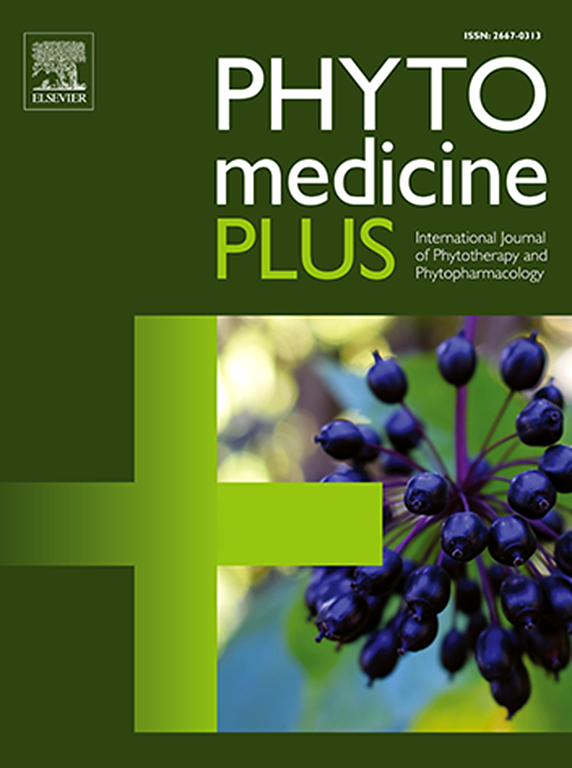Targeting mitochondrial biogenesis: Chandraprabha Vati in the management of metabolic syndrome
Q3 Pharmacology, Toxicology and Pharmaceutics
引用次数: 0
Abstract
Introduction
Metabolic Syndrome (MetS) is an assortment of indications like obesity, dyslipidemia, and hyperglycemia, often linked to glucose intolerance, mitochondrial dysfunction, and low-grade inflammation. Chandraprabha Vati (CPV) is an Ayurvedic herbo-mineral formulation known for its antihyperglycemic and antilipidemic properties.
Objectives
To compare CPV's impacts alongside the hypoglycemic effects of metformin and the lipid-lowering effects of fenofibrate, in addition to evaluating CPV's capability to improve MetS-associated complications by promoting mitochondrial biogenesis.
Materials and Methods
After ten weeks of a high-fat diet with 10 % fructose (HFFD), Sprague-Dawley (SD) rats resembling the condition of MetS. Later, followed by CPV treatment (p.o.) for five weeks treatment with CPV. The study evaluated the effects of the interventions on anthropometric parameters, lipid profile, serum insulin, and levels of inflammatory markers such as TNF-α and IL-6. Furthermore, it evaluated the expression of genes related to inflammation and mitochondrial function, like NOD-like receptor protein 3 (NLRP3), caspase-1, mitochondrial transcription factor A (TFAM), and peroxisome proliferator-activated receptor gamma coactivator-1 alpha (PGC-1α).
Result
: Compared to the disease control group, CPV at 100 mg/kg showed a significant reduction in body weight and improvements in anthropometric parameters, glucose tolerance, lipid profiles, and insulin sensitivity. The serum levels of inflammatory cytokines TNF-α and IL-6 were markedly decreased. CPV treatment upregulated the mRNA expression of mitochondrial biogenesis markers TFAM and PGC-1α while significantly downregulating inflammasomes such as caspase-1 and NLRP3 in cardiac, liver, and skeletal muscle tissues.
Conclusion
CPV could effectively combat mitochondrial dysfunction and chronic low-grade inflammation associated with MetS in rats.

靶向线粒体生物发生:Chandraprabha Vati在代谢综合征管理中的应用
代谢综合征(MetS)是指肥胖、血脂异常和高血糖等适应症,通常与葡萄糖耐受不良、线粒体功能障碍和低度炎症有关。Chandraprabha Vati (CPV)是一种阿育吠陀草药矿物质配方,以其抗高血糖和抗血脂特性而闻名。目的比较CPV与二甲双胍的降糖作用和非诺贝特的降脂作用,并评估CPV通过促进线粒体生物发生改善mets相关并发症的能力。材料和方法经过10周的高脂饮食(含10%果糖),Sprague-Dawley (SD)大鼠出现类似MetS的情况。随后进行CPV治疗(p.o.), CPV治疗5周。该研究评估了干预措施对人体测量参数、血脂、血清胰岛素和炎症标志物(如TNF-α和IL-6)水平的影响。此外,该研究还评估了炎症和线粒体功能相关基因的表达,如nod样受体蛋白3 (NLRP3)、caspase-1、线粒体转录因子A (TFAM)和过氧化物酶体增殖物激活受体γ辅助激活因子-1α (PGC-1α)。结果:与疾病对照组相比,100 mg/kg CPV组的体重显著降低,人体测量参数、葡萄糖耐量、脂质谱和胰岛素敏感性均有改善。血清炎症因子TNF-α、IL-6水平明显降低。CPV处理上调线粒体生物发生标志物TFAM和PGC-1α的mRNA表达,同时显著下调心脏、肝脏和骨骼肌组织中炎性小体caspase-1和NLRP3的mRNA表达。结论cpv能有效对抗大鼠线粒体功能障碍和慢性低度炎症。
本文章由计算机程序翻译,如有差异,请以英文原文为准。
求助全文
约1分钟内获得全文
求助全文
来源期刊

Phytomedicine Plus
Medicine-Complementary and Alternative Medicine
CiteScore
3.70
自引率
0.00%
发文量
178
审稿时长
81 days
期刊介绍:
 求助内容:
求助内容: 应助结果提醒方式:
应助结果提醒方式:


